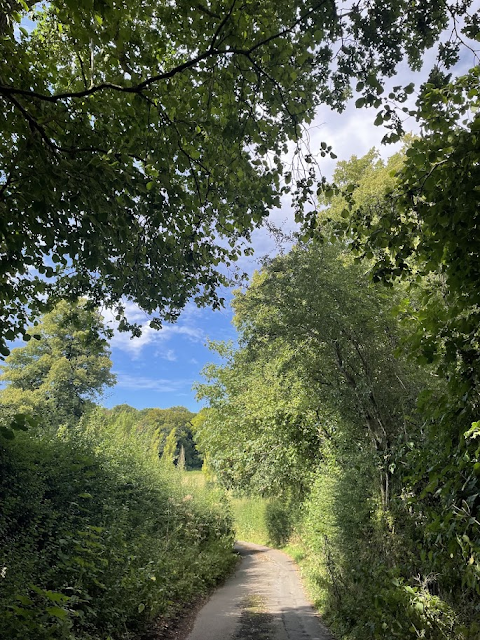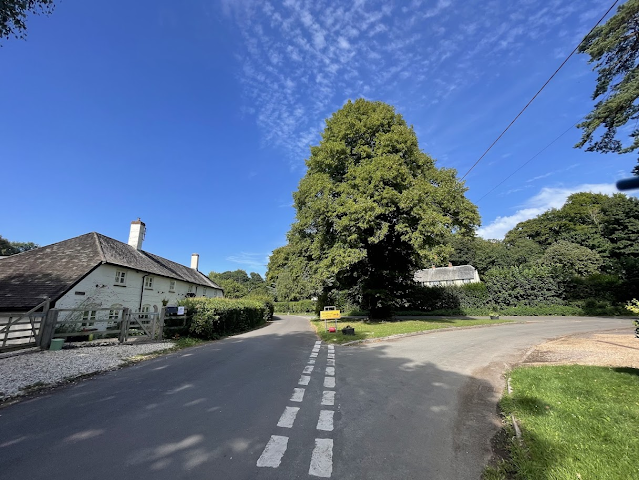Having got hold of the late Deirdre Le Faye's intriguing guidebook to Jane Austen's Steventon from Basingstoke Library's excellent Jane Austen collection, I thought I might have a walk around the village to get a good idea of what it looked like in Jane Austen's times. Le Faye did extensive research into the area, looking at parish records and such like to build a picture of village life from the medieval times to today.
Steventon is situated about six miles south-west from Basingstoke and neighbours the parishes of Ashe, Deane and North Waltham. The parish of Steventon itself is a long, narrow stretch of land about 3 miles long and 2000 acres large. The village dates back to the Roman and Anglo-Saxon times, and Le Faye writes that the name of Steventon may have come from the Anglo-Saxon word, "Stif-in-tun" (the tun or homestead of Stif's people).
It was a lovely day for a walk, and Steventon was as peaceful as always and lush with its late summer greenery and golden yellow fields. It is easy to imagine Jane walking through narrow lanes (muddy though as they would have been back in the day), but little has changed in this ancient, idyllic village.
Jane lived in Steventon from her birth in 1775 to 1801 when she was forced to relocate to Bath with her family. Steventon Rectory was situated at the crossroads between Steventon Road and the road leading to St Nicholas Church where her father was rector.
The rectory stood in this field, now barely visible to due all the overgrown summer vegetation and greenery. On the left there was a well, and a photo of its pump (now hidden by vegetation) can be seen in my earlier posts.
The rectory had five rooms on the ground floor, seven bedrooms and three attics. In size and look it was very similar to Chawton Cottage where Jane moved later in life.
At the back, the family grew vegetables and flowers and kept some dairy cattle and poultry. Anna Austen writes, "The walls of the inner garden were covered with cherry and other fruit trees...I remember this sunny cucumber garden - its frames, and also its abundance of pot-herbs, marigolds, etc." (p.50, Le Faye). Mr Austen also grew some crops, and his glebe-land farm was managed by his bailiff, John Bond, who served the family for a very long time. They also kept a cook ("Nanny" Littleworth), a washerwoman (Dame Bushell) a groom/coachman (Nanny's husband John Littleworth) and a housekeeper/ladies' maid (Anne Hilliard).
When Mr Austen decided to retire to Bath in 1801, his eldest son, James, became his father's curate and later, following his father's death, Rector. James continued to live in Steventon Rectory and planted this large lime tree in front of the house in 1813, together with his son, as a token of their mutual love.
Sadly James passed away in 1819, and the living conditions in the Rectory soon became squalid. There was a severe flood in the winter of 1820, which had made the downstairs of the Rectory so damp that it was almost unlivable: Caroline Austen remembers, "It was an unusually severe winter, and much snow fell. A thaw came on suddenly and one night we were roused by water pouring into the cellars... and on going down the men found all the ground floor under water.... the next morning, the cellar looked like the scene of a shipwreck... the hall and the two parlours retained so much dampness that we never lived downstairs again, and had all our meals brought upstairs".(p. 33, Le Faye)
Henry Austen then took orders and became Rector, but his tenure only lasted for 3 years and during that time, he was in no position to re-build the house. The living was then bequeathed to William Knight, one of Edward Knight's younger sons. Edward, who had not thought of rebuilding the house when his brothers stayed there, then decided to pull down the rectory and build a new rectory for his own son on the field across the road. This house can be seen from the road (and has recently been advertised for sale).
As I walked towards Steventon Church, I admired the tree branches forming beautiful arches across the road.
Approaching Steventon Church from the south, you can see a large yew tree, which is about 800 years old.
The church was built in the 1200s by the then lords of the manor, the Luvers family, and was dedicated to St Nicholas - in fact, there are around 400 churches in England dedicated to this saint. Please refer to my earlier post for photos from inside the church.
Steventon Manor, a house rented by the Digweed family, used to be directly opposite but has been replaced by a modern building.
There is a seat in the middle of the triangle, facing a row of whitewashed cottages called Elm Tree Cottage, which was there during Jane Austen's times.
The house to the left of Elm Tree Cottage is called Jasmine Cottage. This house previously used to be a smithy; however, I have seen it mentioned that Jasmine Cottage may have been the house where Jane lived with her wet nurse. As was customary within the gentry circles, Jane Austen was sent to be nursed by one of the mothers down in the village (likely the large Littleworth family) for the first few years of her life until she was able to walk and talk. Judging from her letters, Jane was close to the villagers, and this closeness may well have been the result of living so closely with village people during some of her most formative years. She continued to donate items of clothing that she had made or purchased to the poorer villagers.
Jasmine Cottage
Walking down Ashe Park Lane, there are some more modern houses that were built later on, but Jane would have been familiar with Yew Tree Cottage.
Yew Tree Cottage
Also down Ashe Park Lane is Bassett's Farm, which during Jane's time was part of Steventon Manor Farm, run by the Digweed family who lived opposite St Nicholas Church, and such a large farm that it covered nearly the whole parish.
Jane was also familiar with the two Hatch Cottages at the crossroads of Waltham Lane and Ashe Park Lane.
There was no inn in the village, the closest one being the Deane Gate Inn a few miles away. The Austens would often board a stagecoach from here. When I last saw the building, it looked rather derelict, and I was pleased to see a new brasserie being opened there. Rural life in Steventon does look and sound idyllic. The fields were dotted with grazing sheep, and the white-washed cottages were covered in grapevines and woodbine. It was in these cottages that villagers lived, and James-Edward Austen-Leigh in his Memoir remembers the cottagers' wives sitting at home spinning flax and wool. Many of the cottages in Steventon, though well-kept, became damp and were later replaced with more modern buildings, but it is delightful to see a selection of the original period architecture in the village, and the character of the village remains authentic and unspoilt.
As I was walking down the lanes of Steventon, I stopped to overhear an elderly gentleman chattering with a neighbour in the local, rural Hampshire dialect, with rounded vowels and rolled r's, and I truly felt like I had gone back in time to the 1800s.
References and further reading:
Austen-Leigh, J.-E. (2002) A Memoir of Jane Austen. OUP.
Le Faye, D. (2007). Jane Austen's Steventon. Sarsen Press.
Do have a look at my earlier blogs as well:
Steventon Church:
https://austenised.blogspot.com/2019/07/uncovering-steventon-church.html
Places around Steventon:
https://austenised.blogspot.com/2019/08/adventures-around-jane-austens.html
Steventon in winter:
https://austenised.blogspot.com/2019/02/a-drive-through-wintry-steventon.html
My first visit to Steventon:
https://austenised.blogspot.com/2016/08/my-pilgrimage-to-steventon-cradle-of.html


















What a brilliant article Anna. I have been to Steventon and seen the sights before but your pictures and article has gven me so much more information and insight. Tony
ReplyDeleteWhat a brilliant article Anna. I have been to Steventon and seen the sights before but your pictures and article has gven me so much more information and insight. Tony
ReplyDeleteLovely article. Lovely pictures, Anna. I like how you overheard a conversation in the Hampshire dialect.
ReplyDeleteThank you so much, Tony! I'm glad you enjoyed this tour. Observing dialects is my favourite thing!
Delete